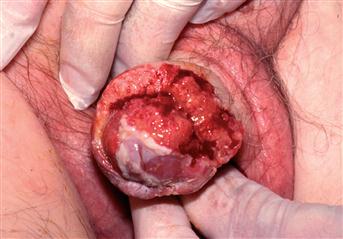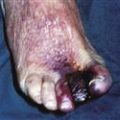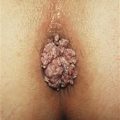Penile Lesions
Penile lesions are common. They interfere with sexual intercourse. The majority of surgical conditions of the penis relate to problems with the foreskin and glans and the need for circumcision. Carcinoma of the penis and Peyronie’s disease are rare.
History
Foreskin and glans
Phimosis
In most cases, phimosis is congenital. The foreskin has been tight since birth and the patient complains that it will not retract over the glans. In children, this may cause ballooning of the foreskin during micturition, with resulting balanoposthitis. In adults, the complaint is that it interferes with sexual intercourse.
Paraphimosis
This is a result of a patient having a phimosis. The foreskin is pulled back over the glans while washing and then is not returned. It may also occur during sexual intercourse. In hospital practice, it may occur while the patient is being catheterised and the foreskin is not returned to its correct place following this procedure. The foreskin forms a tight constriction around the glans, interfering with venous return and causing swelling of the glans and foreskin. The patient presents with considerable pain and a swollen glans penis.
Balanoposthitis
This is inflammation of the glans and foreskin. The patient complains of an attack of inflammation of the foreskin and glans. It may be associated with poor hygiene, but in children it is often associated with phimosis and collection of urine under the foreskin. In diabetics, it is often due to candida.
Balanitis xerotica obliterans
The patient will complain of thickening and tightening of the foreskin, and the inability to retract it.
Herpes genitalis
The patient will complain of painful vesicles on the foreskin or glans penis. There will usually be a history of sexual contact.
Condylomata (warts)
The patient may present with warts on the glans and contiguous surface of the prepuce. They are usually of venereal origin.
Trauma
There may be a history of trauma, often of an unusual nature. Love bites may be responsible.
Carcinoma
This usually presents in old age. It is virtually unknown in those who are circumcised. Most patients present with a lump or an ulcer which may be painful. In uncircumcised patients who cannot retract the foreskin, there may be a bloodstained purulent discharge from under the foreskin.
Erythroplasia of Queyrat
The patient will present having noticed a dark, velvety, red, flat patch on the skin of the glans.
Syphilitic chancre
A chancre presents as a painless, hard ulcer on the penis.
Shaft
Peyronie’s disease
The patient may have noticed a subcutaneous lump along the penis. He may complain that when he has an erection, the penis appears bent.
Priapism
The patient will present with a persistent painful erection. This is unassociated with sexual desire. There may be a history of leukaemia, sickle cell disease, disseminated pelvic malignancy, or the patient may be on haemodialysis. Priapism may also result from alprostadil overdose for erectile dysfunction.
Urethra
Epispadias
This is rare. The patient, a baby or child, usually presents with the urethra opening on the dorsal surface of the glans penis.
Hypospadias
This is more common than epispadias, the patient presenting with the urethral opening on the ventral or undersurface of the penis. In both epispadias and hypospadias, the patient will complain of a problem with micturition.
Examination
Foreskin and glans
Phimosis
The foreskin is tight and has a pinhole orifice. It will be impossible to retract it over the glans penis. There may be associated balanoposthitis.
Paraphimosis
The diagnosis is usually obvious. The glans penis is swollen and oedematous and there is a deep groove just proximal to the corona glandis, where there is a tight constricting ring of skin. The patient is obviously in pain.
Balanoposthitis
There is inflammation of the glans (balanitis) and often associated inflammation of the foreskin (posthitis). There may be a discharge from under the foreskin. In the case of candidiasis, there are itchy red patches on the glans. There may be evidence of poor personal hygiene.
Balanitis xerotica obliterans
The foreskin is thickened, with loss of elasticity and fibrosis. It is usually not possible to retract it over the glans.
Herpes genitalis
Initially, there will be itchy vesicles but these develop into shallow, painful erosions. There may be associated painful inguinal lymphadenopathy.
Condylomata (warts)
There will be a bunch of warts, usually around the junction between the foreskin and the glans and extending onto the glans.
Trauma
Appearance will depend upon the type of trauma. Teeth marks may be apparent.
Carcinoma
The lesion is usually at the junction of the foreskin and glans. There will be a lump or ulcer. If there is an ulcer, it will have raised everted edges and a necrotic base. It feels hard. The inguinal lymph nodes may be affected, either by metastases or by secondary infection. In patients in whom the foreskin cannot be retracted, it may be necessary to carry out circumcision to make the diagnosis.
Erythroplasia of Queyrat
There is a dark-red, flat, velvety, indurated patch on the glans penis. It is a premalignant condition and represents carcinoma in situ.
Shaft
Peyronie’s disease
There are plaques of fibrosis in the corpora cavernosa. These may be felt as hard lumps along the corpora cavernosa. The patient will volunteer the information that the penis becomes bent on erection.
Priapism
The diagnosis will be obvious, there being a painful erection.
Urethra
The diagnosis of epispadias and hypospadias will be obvious. In hypospadias, the opening of the urethra may be anywhere along the line of the urethra, from a few millimetres from the tip of the penis to the perineum. In epispadias, which is rare, the urethral opening is on the dorsal surface of the glans penis.
General Investigations
Specific Investigations
■ Sickle cell test
Sickle cell disease with priapism.
■ Electron microscopy
Identification of herpes virus in vesicular fluid.
■ PCR
For rapid diagnosis of herpes.
■ Biopsy
Erythroplasia of Queyrat. Carcinoma. Condylomata.
■ Circumcision
Diagnostic if tight phimosis prevents retraction of foreskin to inspect glans for carcinoma.





